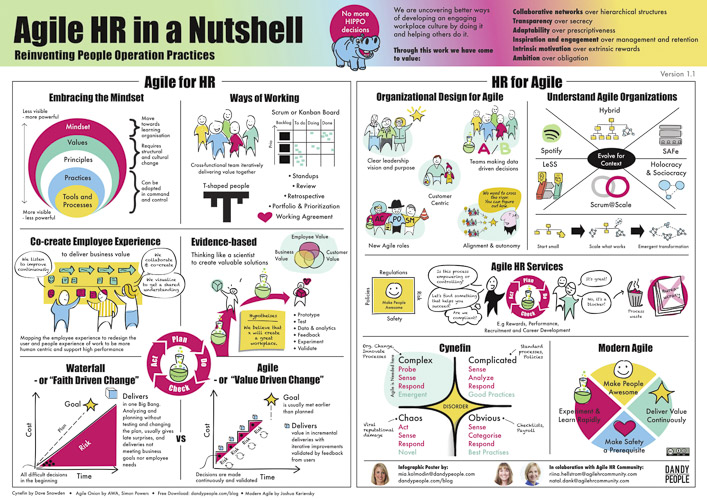Talking with Human Resource (HR) leaders around the globe it’s clear that the need to develop business agility dictates strategic agendas. If we then consider the HR function itself, most teams face the same problems and share the need to modernise, digitalise and deliver value at speed. As a result, the HR profession is in catch-up mode when it comes to Agile. Not only do we need to quickly understand what Agile means in order to guide wider organisational transformation, but also begin to apply the mindset ourselves to revolutionise our own ways of working.
Helping you understand Agile HR
Agile HR is an exciting topic but it can be intimidating at first and hard to contextualise. To help explain the key elements of Agile HR each section of this guide follows the ‘Agile HR in a Nutshell’ infographic designed in collaboration with Mia Kolmodin of Dandy People. We’ve also done a video to compliment this blog.
There are two distinct aspects to Agile HR – Agile for HR and HR for Agile. Let’s delve into the details of each, starting with Agile for HR.
Agile for HR
Agile for HR looks at how HR can apply an Agile mindset and various working methods within our own teams and projects. Agile for HR has the potential to reinvent our operational model and help us modernise as a profession. You don’t even need to work in an Agile organisation to do Agile for HR and can realise the benefits very quickly by applying a few basics steps in your everyday work.

Embracing the Mindset
Agile is all about the value you deliver to your customer and your business. In HR we talk a lot about the need to ‘add value’ but often struggle to clearly quantify and define what this value is. Most HR strategies contain big complex topics, such as designing a personalised employee experience for a multi-generational and diverse workforce. Or developing future leaders for roles that don’t even exist yet. While these complex goals are worthy aims, the value being delivered at any one point in time is often left undefined or linked directly to big bang releases, such as a new employee benefits package or leadership development program.

As a remedy, Agile helps HR break these big complex topics down into achievable slices of value. It helps us prioritise our work based on value, and clearly articulate what we’re delivering to the business and why we’re doing it.
Human-centric value
Agile HR mindset is also about our people being the customer and user of the employee experience. When viewed this way, value begins to represent something that delights the customer and helps the employee be successful in their job. It also creates a need to design human-centric people practices that are validated through the direct feedback of the users. This is a very different perspective to designing HR services and processes based on previous best practice or what management assume the organisation needs.
Incremental development
Next, Agile HR aims to incrementally deliver this value to the customer. Now, the word ‘incremental’ is significant here and represents a big mindset shift for HR. Incremental means delivering value through small, step by step change, that is validated through a test and learn approach. This is the Agile feedback loop and a conscious move away from rigid upfront planning that fails to adapt to evolving customer needs, a change in project scope or simply a better idea.
Moving beyond the tools
All of this means Agile HR mindset is more than just Post-it notes, Scrum boards and a few stand-ups. It is about truly stepping out of the tradition of following HR best practice and embracing a test and learn approach to deliver value, value that is validated by our people and their experience of work. Only once HR embrace this mindset can the profession successfully adopt Agile tools and practices within our own teams and projects.
“You don’t even need to work in an Agile organisation to do Agile for HR and can realise the benefits very quickly by applying a few basics steps in your everyday work”
Ways of Working
Once comfortable with the mindset HR teams can start evolving their ways of working with Agile frameworks. It’s worth noting that, like Agile itself, no blueprint exists for how to do Agile HR. It’s important to find your own flavour based on your culture, industry, team size and business needs.
Find your own Agile HR model
This means some teams use the Scrum framework, and sprint back to back each week, with the aim of driving rapid innovation and delivery. Where others prefer a Kanban board to manage a constant flow of daily tasks. Often combined with activities like retrospectives and stand-ups to ensure they continuously improve and remain dynamic. Whatever your approach the key is to find it through a test and learn cycle.
In Agile, the concepts of experimentation, and test and learn, apply just as much to how you work, as they do to the work you get done. That being said, there are a few important commonalities across all Agile HR teams, that we’ll now review.
No more HR silos
The first is an end to HR silos. Agile argues that handovers and deferred decisions slow you down. Instead, Agile advocates multi-skilled, self-organising teams, that can make quick decisions in response to customer needs. To support these ways working the teams use visualisation tools, like Scrum or Kanban boards (both digital and physical), to ensure work is transparent and ruthlessly prioritised.

Just imagine the power of multi-skilled Agile teams, made up of HR plus other people from the business, solving our complex organisational problems. For too long we’ve been slowed down by our Ulrich-inspired model of single point topic owners, such as recruitment versus talent, and the separation of generalists and specialists.
Agile HR transforms the HR operative model and starts to build a pool of multi-skilled people able to innovate and design together. These Agile HR teams can also service different parts of the business based on who is available and who has the skills, rather than following pre-determined relationships or roles to execute a task.
Agile HR Cadence
Another commonality is the introduction of a new cadence or rhythm in how we work. Traditionally, HR has worked with an annual cycle, sometimes with half-year or quarterly check-ins. However, in our modern and ever-changing world, whole businesses can rise and fall in this time. Instead, Agile embraces a shorter time frame, and asks teams to check-in and replan at least monthly, with many teams working in 1 or 2-week cycles.
This cadence is also based on the Agile feedback loop which starts with planning and prioritisation. The team then get on with their work, ideally checking-in every day by holding a stand-up. At the end of the loop, the team showcases the value they delivered to their customers and gather feedback to help them plan the next increment or cycle of work. By holding a retrospective, the team also assesses how they worked together, with the aim of continuously improving.
What’s more, while the Agile loop is primarily a team-based rhythm, this cadence can start to drive continuous improvement throughout the organisation. With HR topics like performance, learning directly and career development, interlinked.
Prioritisation and transparency
The last significant commonality between most Agile HR transformations is the use of Agile tools to guide prioritisation and the visualisation of work. At a strategic level, people initiatives and services are prioritised based on business value and visualised through a portfolio of work. For example, some Agile HR teams use prioritisation methods to co-create a high level backlog directly with senior stakeholders and employees, which guides their more detailed work each quarter.
This high-level vision then feeds directly into team level and project-based backlogs, where decisions on how to get things done are made. Transparency of information is central to these ways of working and another important change that helps HR become accepted as another part of the business, rather than seen as the secret fun police.
Indeed, Agile demands that HR leaders and teams are more planned and organised than ever before. It’s a fallacy that Agile means ‘no rules’ and do what you want! Real discipline is needed, one that transforms the HR model into rapid feedback loops and delivery, rather than yearly operational plans, project reports and annual systems.
HR often talk about the need to have a seat at the table. However, in the past we’ve lacked the data to inform our view and successfully contribute to the business discussion. Working evidenced-based solves this problem.
Co-creating Employee Experience
Co-creating employee experience is perhaps the most powerful element of Agile HR. It’s also the easiest place to start and something you can do even if you don’t work fully Agile yet.

Co-creation invites your people to experiment with you, and test what works and what doesn’t. It draws on techniques used in design thinking, such as personas, experience mapping and prototyping. There are lot of great frameworks available to use, all of which help you to put yourself in the shoes of your customer and redesign the experience of work.
The outcome is organisational change through collaboration. Instead of managing people through the change, they now co-create it with you. This way of working not only transforms HR’s work but that of any organisational change project, such as process redesign, cultural initiatives and system implementations.
Discovery work in HR
The power of co-creation links to the importance of discovery work in Agile, where you should never assume the answer or what the customer values. Instead, you need to discover what the answer is through research, prototyping and most of all, talking to the customer!
This is very different to collecting people’s opinions through an engagement survey. It’s about putting something physical in their hands or creating an experience to assess their reactions and responses. Some teams use Plasticine and Lego, while others run mini real-life experiments. It can even be as simple as walking the corridors and asking people to give you feedback on a piece of communication before you hit ‘send’.
Experimentation versus pilots
‘Yes, but I already pilot’, is the usual answer given by many in HR at this point but experimentation and prototyping are vastly different to running a pilot. Too often a pilot in HR already represents a big investment of time and money.
For example, if it’s a management development program, often the tender process has been decided, your top managers are in the room and the supplier is now expected to deliver. Even if the pilot feedback is poor, the program isn’t stopped and instead is tweaked and repackaged as much as possible, so it can still be rolled-out as scheduled.
Instead, the Agile HR approach would experiment with different learning experiences first or do some discovery work on what skills are needed and when.
REAL WORLD EXAMPLE: A team practicing Agile HR at a large media company discovered a way to deliver on-demand learning experiences at the exact moments when managers needed to develop these skills. Unsurprisingly, this was mainly linked to key moments when managers faced a difficult conversation or new team situation.
Evidenced-based
It’s time for HR to think like a scientist, to test assumptions and hypotheses to demonstrate through data why HR, let alone the whole business, should embark on workplace change.
All the methods mentioned so far, such as experimenting, prototyping and driving a continuous feedback loop, harness an evidenced-based approach. These methods can also be used without need for your team to go ‘fully Agile’.
HR often talk about the need to have a seat at the table. However, in the past we’ve lacked the data to inform our view and successfully contribute to the business discussion. Working evidenced-based solves this problem.
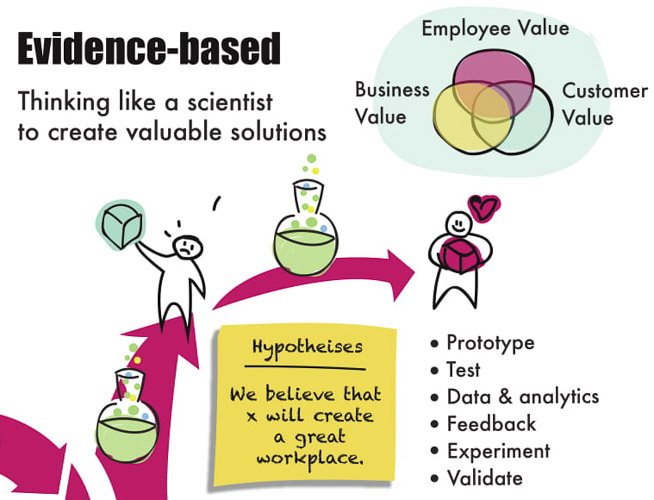
Managing HiPPOs
The other main reason HR need to work evidenced-based is to manage our HiPPOs – our Highest Paid Person’s Opinion. It’s only natural that our CEO or senior executives have strong views on how to develop their people or what culture means. The only problem is often their opinion is just that, a gut instinct, lacking validation with the people doing the job day to day. HR can counter this by working evidence-based and gathering data to validate a project before committing lots of time and money.

REAL WORLD EXAMPLE: One Agile HR team went to redesign their graduate program because they were losing people between the acceptance date and when the graduate program started. However, through research and testing they discovered all that was needed was a phone call before the start date from their new manager to ensure they turned up, rather than a whole new graduate program.
Waterfall versus Agile
Agile began in software development in the late 1990s as a response to the need to deliver products in a continuously changing market environment. To deal with this increased complexity, Agile incorporates the need to change directly into how a product or project is delivered. Agile ways of working are now proving so successful that nearly all tech is developed this way, and whole organisations, including non-tech businesses, want to ‘go Agile’.

No more ‘big bang’. No more ‘one-size-fits-all’.
Moving away from a waterfall approach to delivering value incrementally is ground-breaking for HR. The traditional approach has been to blueprint whole HR systems and processes upfront and release them into the business through a one-size-fits-all, big bang implementation. Instead, Agile invites HR to test an idea or hypothesis first, and only begin the project once there is the evidence HR has discovered what works and what doesn’t.
Agile as risk management
Not only does this approach decrease project risk, but if something fails, a new direction can be taken. This built-in ability to adapt to change, means we can pivot and re-plan as customer needs evolve or the business environment shifts. This approach also decreases the risk of committing time, money and people into a flawed idea.
REAL WORLD EXAMPLE: An Agile HR team tested a new feedback app as part of a wider project to redesign performance and reward. Being a tech-based team, the expectation was they’d love an app-based solution. However, the business teams hated the feedback app. It turned out that they didn’t need an app to help them give feedback. What they needed was a safe space free from top-down performance ratings and bonus numbers to give feedback to each other openly. Luckily, the Agile HR team could simply end the app experiment there and start to evolve what mattered most instead.
HR for Agile
HR for Agile looks at our role in helping the organisation transform to meet the challenges of an increasingly complex business environment. HR for Agile looks at how to design modern workplaces by combining all our previous know-how in organisational development with Agile ways of working. HR for Agile also focuses on the need to redesign existing HR and people practices, to enrich the employee experience and enable business agility throughout an organisation.

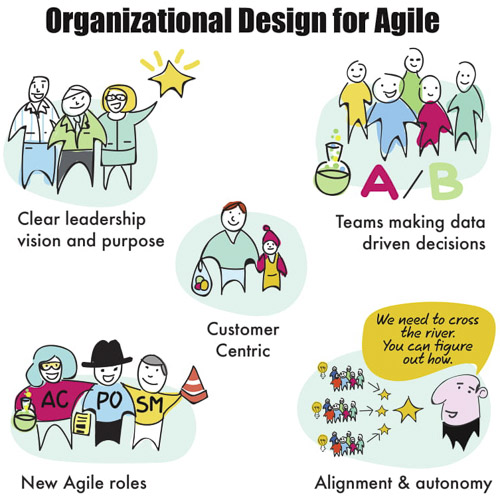
Organisational Design for Agile
In response to today’s complex business environment organisations across the globe are seeking increased business agility to stay competitive, let alone lead the market. To be successful, businesses now require a deep understanding of their customers, a purpose led brand, quick data-driven decisions and collaborative teams able to continuously innovate and deliver immediate value to their customer.
Agile mindset and ways of working are now seen as central in realising these organisational design goals. It also means that organisational structures are becoming more digital, networked and flatter. These trends demand an update in HR’s organisational design capability to ensure we can successfully guide the development of modern businesses and the future of work.
A new HR capability
For example, how do we break down silos and build end-to-end value streams based on digital products or customer journeys? Or what does it mean to evolve a traditionally bureaucratic and hierarchical organisation towards more collaborative and team-based methods of working?
More importantly, as Agile ways of working grow throughout the business out-of-date HR practices can quickly become blockers for these more fluid and adaptive ways of working. For example, an annual performance management cycle and individualised reward structures linked to ratings and job grades, can start to conflict with working models based on networks and team collaboration.
New Agile-based roles
Sometimes this new HR capability can be as simple as helping leaders understand the types of roles Agile brings into the organisation.
REAL WORLD EXAMPLE: A financial tech company undergoing an Agile transformation is currently struggling to help managers recognise and reward the work of a Scrum Master. The job doesn’t fit with traditional, hierarchical concepts of work, and the performance of a Scrum Master is intrinsically linked to the teams they coach and the wider success of Agile within the organisation. This situation has led to HR needing to educate managers in how to capture and recognise a Scrum Master’s contribution to the business.
Understand Agile Organisations
Agile is first and foremost a team-based model. So, what happens when you need to scale this model and have multiple teams, perhaps even hundreds, working together to deliver products at speed?

Based on your product suite you may need to have multiple value streams feeding into different products or have multiple teams coordinating across the organisation to deliver a holistic customer journey. For most organisations, not all teams will be working fully Agile, or use the same Agile working methods. This means you need to consider the governance across the business.
Whatever Agile Model you work with, e.g. a hybrid model or a ‘Spotify’ model made up of tribes and squads, it’s important for HR to get comfortable with how and why we scale.
Scaled Agile models
Traditionally, HR professionals could assume a similar operative model when we moved from one organisation to the next. Instead, Agile is introducing several possible models, sometimes even within the same organisation. An HR professional now needs to know the difference between a ‘SAFe business’ and a Scrum@Scale design and where their role fits within both. These operative and governance models are totally new both for HR and the organisations embarking on these transformational journeys.
Contextual design
It isn’t necessary for HR to become an expert in every model available. However, it is vital to understand why they exist, what each model is trying to achieve, and how to evolve your own model to fit your culture, product and values.
The lesson here is to embrace an Agile test and learn approach to build a contextual design. The danger is that leaders often view these models as a blueprint, to be implemented Waterfall-style, and end up just amplifying problems rather than scaling up efficiencies and synergies. Instead, HR needs to help leaders evolve a working model to fit their specific culture and industry, and use discovery work to co-create this change.
Agile HR Services
By now you’re probably realising the implications of Agile organisational transformation for HR are huge. As organisational structures become more fluid, the static frameworks of HR best practice, such as annual performance appraisals, managed career pathways and documented job descriptions, are failing to meet the needs of our rapidly changing, multi-generational and diverse workforce.

Out-of-date HR model
Most of the existing HR models are out-of-date, even if you don’t work within an Agile business. Too many companies are stuck with heavy compliance driven, bureaucratic and siloed HR processes and systems. An HR model reflecting the legacy of top-down decision making, a pyramid hierarchy and a human view where workers need to be closely monitored and assessed. As a result, we sometimes hear from other parts of the business that we’ve lost the human touch, focus too much on form filling and even impede the delivery of business value.
Rethinking HR
To update the HR model, we need to move beyond cosmetic changes, such as introducing pulse-surveys or digital peer feedback tools. What is required is a fundamental rethink, where HR steps into the experience of work and starts to redesign it from the user’s perspective instead of HR’s perspective. Agile HR can help all HR professionals reinvent their people operations to be more human-centric and deliver business value, no matter what industry or type of organisation you work in.
Innovate within constraints
Of course, we must always be mindful of the constraints we work within and how to innovate within these constraints. At all times we must protect the rights of our people and the compliance needs of our business. However, let’s map these out and be clear on where we can innovate. If we trust our people to make adult decisions, we can build systems and processes based on their user experience, rather than just rules and regulations.
REAL WORLD EXAMPLE: A company wanted to redesign their performance management system and was considering a more open and transparent process that no longer used performance ratings and forced rankings. However, some managers were fearful that they wouldn’t be able to address the problem of low performance if they no longer had ratings to use. The HR team therefore researched the problem further and found that it was very rare for managers to give low ratings, even when they had a low performer in their team. They also found that real-time feedback conversations were far more effective in dealing with poor performance, as opposed to ratings. As a consequence, they set about designing a new performance management system that aimed to support everyone’s performance and career development, rather than a compliance need or box ticking exercise.
Cynefin
Dave Snowden’s Cynefin model is a great framework to help HR professionals understand why Agile mindset has evolved in response to complexity.
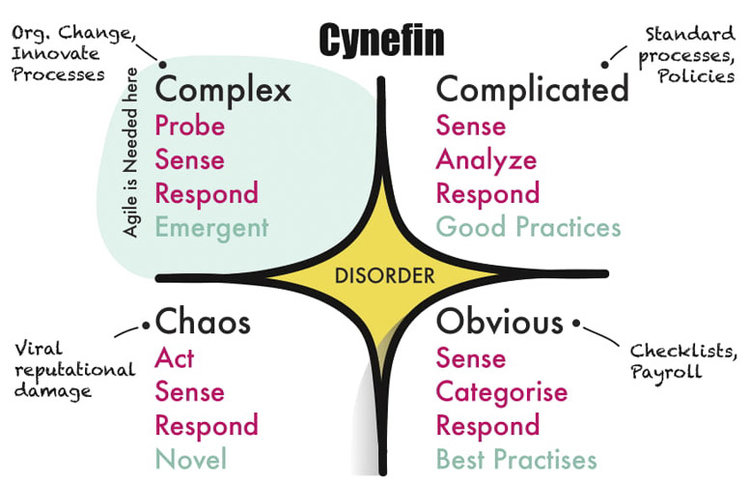
Place of multiple belongings
Cynefin, is a Welsh word, that means place of multiple belongings, and the model helps us explore how different work practices and decision making can coexist simultaneously.
By applying the framework, people can sense which context they’re in and aim to make better decisions by following certain responses. The framework also helps us avoid problems when we apply our preferred management or decision-making style in the wrong context.
Complex HR problems
For example, it’s common for HR to assume a clear cause and effect to a problem and attempt to solve it through a simple solution, like introducing a checklist or new form to fill in. We also love to engineer a complicated process to manage a project or change, only to unearth more and more complexity, and interlinked problems, as we attempt to implement this new process.
Instead, for many HR initiatives, such as cultural or behavioural change, the answers are at first unclear and the problems multi-layered. In these situations, we can only begin with what we know now, and enter the unknown through a test and learn approach. By working this way, we begin to acquire knowledge and data, which allows the answers to emerge, incrementally, step-by-step.
Modern Agile
Essentially, the Modern Agile framework takes the history of the Agile manifesto and modernises it for our current times. The good news is that the framework greatly resonates with HR and modern people practices. It’s four guiding principles are:
- Make People Awesome – hell yes!
- Make Safety a Prerequisite – this is about the need build psychological safety to develop an Agile culture of feedback and learning, as well as the responsibility in HR to keep our people safe as they work.
- Experiment & Learn Rapidly – yes, you got it, the basis to the Agile feedback loop and how we co-create the employee experience.
- Deliver Value Continuously – which is how HR reserves its seat at the table.
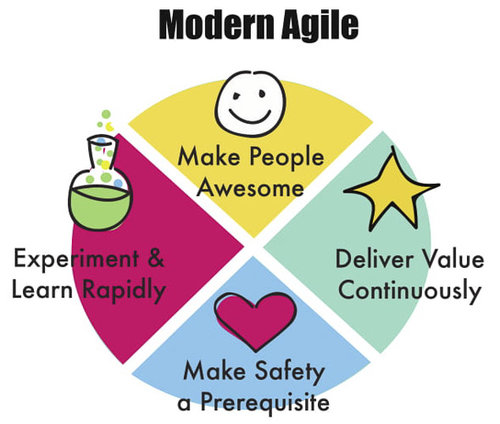
Conclusion – Start small and experiment
Agile HR has the potential to revolutionise our profession and help us co-create the future of work. It also equips us with the capability to help our organisations transform and meet the challenges of a volatile, uncertain and complex business world.
We’ve learnt that the starting point is mindset and HR’s ability to define and articulate the value we deliver to our people. By embracing a test and learn approach, and incrementally develop solutions in partnership with our people, we can enrich their employee experience.
And remember to be Agile in your own approach when learning how to do Agile HR. Start small. Treat it as an experiment, in which you might fail at times but will definitely learn from and allow the energy Agile ignites to move you forward.

